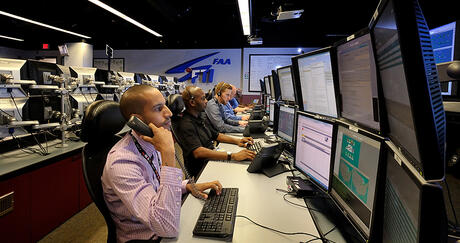Each day leading up to landfall, L3Harris Technologies’ Federal Aviation Administration (FAA) Telecommunications Infrastructure (FTI) Program’s Contingency Disaster Recovery (CDR) team reviewed the storm’s projected path and its increasing strength. They prepped for a potential U.S. landfall in the gulf coast, monitoring what service sites for the FAA could be in the path of the storm. The FAA reached out to L3Harris’ FTI District Service Manager and advised they would be going to Readiness Level Charlie across the gulf states from Beaumont, Texas to Mobile, Alabama. This meant they would initiate preparatory actions, such as deploying emergency repair crews, in advance of the potential natural disaster.
The FTI CDR team closely communicated with the FAA’s National Airspace System (NAS) Security and Enterprise Operations (NASEO) team and our telecommunication partners to provide situational awareness updates, emphasize the importance of swift facility restoration in the event the storm caused damage, and to identify what critical services would need priority restoration. The FAA requested L3Harris deploy and forward stage mobile satellite assets to Atlanta, Georgia and Shreveport, Louisiana in preparation for service recovery efforts. The FTI CDR team also ensured any L3Harris employees in the path of the storm were prepared and safe.
Based on the projected track, the FTI CDR team identified 81 FAA sites and 342 services likely to be impacted. As the storm made landfall, the FTI Primary Network Operations Control Center (PNOCC) in Melbourne, Florida began to identify storm-related service outages as the telecommunications infrastructure became inundated. Receiving a request for assistance from the FAA NASEO team, FTI Operations responded immediately and the FTI Satellite Communications (FTI-SAT) engineering team was sent to the impacted areas. The first FTI-SAT team dispatched to Shreveport, Louisiana where they met with the FAA Disaster team to assess facility service outages and discuss priority service restorations.
Two days after landfall, initial damage assessments identified over 250 services in Louisiana impacted by Hurricane Ida. Many FAA sites had sustained power loss and telecommunication infrastructure damage, with some sites having major damage and no expectation for a rapid recovery.
To restore vital services for the NAS, L3Harris’ FTI-SAT engineers quickly responded and coordinated with the satellite network provider, SES, and the ground receiving partner, UltiSat to assess the system availability and deploy the emergency FTI-SAT assets. The FAA NASEO team identified additional critical service restoration areas and requested a second satellite communications system to support Remote Transmitter/Receiver (RTR) services in Galliano, Louisiana. The team dispatched and restored services to RTR services in Houston and Galliano using temporary and long-term satellite communications solutions to maintain operations while damage to facilities could be addressed.
“In the face of these types of disasters, it’s critical that L3Harris works quickly to ensure the continuity of FTI Services to ensure the safety and security of our skies,” explained Hunt Fitch, FTI-SAT Engineer. “Our response is more than just helping the FAA customer; it’s helping impacted communities. As soon as we can reestablish communications, air traffic can resume which allows more relief into these areas. Our work permits critical disaster relief to begin in a timely manner.”
Of the more than 200 services impacted by Hurricane Ida, only a small percentage remain out of service because of long term power or infrastructure issues. All critical communications were quickly restored and the air traffic in the region resumed normal operations within a week. “I would like to take this opportunity to extend a heartfelt thank you to the team for the nothing short of incredible efforts they put forth to restore NAS services in the wake of Hurricane Ida,” said David Fischer, FAA National Telecommunications Operations Manager. “Repeatedly, in times of communication crisis, the L3Harris FTI team has risen to the occasion and excelled.”
The tireless dedication of the FTI-SAT team and the numerous hours of the FTI Operations and Management team ensured that our customers could return to ‘normal operations’ in the face of disaster. These tremendous efforts paralleled the continuous 24/7 operations of the FTI team as they support over 4000 FAA sites across the country to maintain safe and secure skies.



